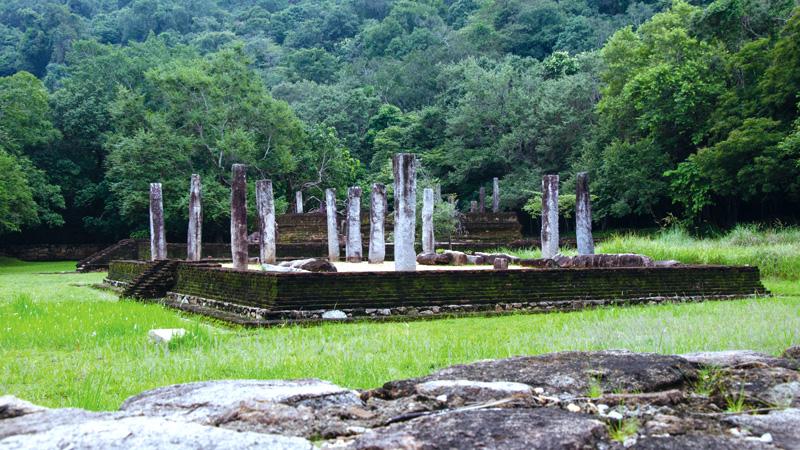
It was morning. We could see the silhouette of the Dimbulagala mountain range with its jagged peaks thrusting against the pale blue sky. The air was a little chilly. The placid water of the Dalukana tank could be seen on the left side of the road, lying in the foot of the Dimbulagala hill. Across the tank, a soft, cool breeze blew through the leaves of trees. The shade and the soothing swishing sound of leaves mesmerised us. We closed our eyes and breathed in the serenity.
 Our destinations were Namal Pokuna Purana Raja Maha Vihara, Dimbulagala Arannaya Senasanaya (forest hermitage) and Dalukana, often referred to as an Adivasi (Veddha) village, 10 km from Manampitiya, an ancient Adivasi village, which was home to one of the earliest Adivasi clans.
Our destinations were Namal Pokuna Purana Raja Maha Vihara, Dimbulagala Arannaya Senasanaya (forest hermitage) and Dalukana, often referred to as an Adivasi (Veddha) village, 10 km from Manampitiya, an ancient Adivasi village, which was home to one of the earliest Adivasi clans.
We were at the Namal Pokuna Raja Maha Vihara, Dalukana, with the expectations of meeting Adivasi Bhikkhu Ven. Millane Sri Siriyalankara Thera, who resided in the temple where Adivasis have left marks of their civilisation in caves, most of which have vanished.
We were told at the temple that the Adivasi bhikkhu now resides in Dimbulagala, after he became a Chief Incumbent of the Dimbulagala forest hermitage. We headed to Dimbulagala to meet the Ven. Millane Sri Siriyalankara Thera. Sitting on a bench under a shady mango tree in front of the spacious compound of the Avasa Ge at the temple on the foot of the Dimbulagala mountain, the Thera spoke about the temple and reminisced his childhood with us.
History
The history of Dimbulagala and its forest hermitage, which had sheltered thousands of Bhikkhus in the past, dates back to the reign of King Pandukabhaya. It had been overgrown with creepers after the Chola invasion and had later become a home for the Adivasi.
Millana Yapa, the last chieftain of the clan who lived in the caves in the Dimbulagala forest had decided to gift all the natural caves to a Bhikkhu along with 12 Adivasi boys, to be ordained as Samanera bhikkhus. Ven. Millane Sri Siriyalankara Thera, Viharadhipathi of the Dimbulagala forest hermitage, was one of these boys.
“When we were small, we lived in caves. We didn’t have money. We took honey, dried meat, maize and fruits such as Mora and Weera to the Kaduruwela town and sold them, got our provisions and returned to our caves. Whenever we suffered from any disease, we used medicine based on tribal methods. We bathed in the Avushadha Pokuna (herbal pond), on the Dimbulagala mountain, which was believed to cure all diseases,” the Thera said.

“The caves were gifted to Ven. Matara Kithalagama Sri Seelalankara Thera by my father, Millana, who was the chieftain of the Adivasi clan in Dimbulagala. The caves which we lived became Buddhist shrines and dwelling places of meditating bhikkhus.”
“The Viharadhipathi built a school for us in Horiwila. It was an enjoyable life in school,” he said.
Enthralling experience
They carried a slate and a slate-pencil to school those days. Returning from school at noon, they would have a dip in the village tank under the scorching sun, an enthralling experience for the children.
“I was ordained a Samanera at the age of seven at the Dimbulagala forest hermitage on June 17, 1965 under the name, Millane Sri Siriyalankara, along with 11 other Adivasi boys. The event received wide publicity. However, I am the only one who remains in the Sasana out of the 12; some have disrobed, while some have died,” he said.
“My teachers were Ven. Kitalagama Sri Seelalankara Thera and Ven. Udupillegoda Pragnalankara Thera. We got up at 4.00 am. We were offered gruel or Kurakkan Thalapa for breakfast. When the Gediya (bell) was rung at 8.00 am, we went for the Buddha Pooja, and later, had our breakfast in the alms hall. We had an interval at 9.30am, when we would go either to the Mahaweli River or to a nearby tank to bathe. We would return for the mid-day Buddha pooja and have the mid-day Dana offered by devotees. Later, we headed to the Pirivena to study”.
The Namal Pokuna ancient Vihara in Dimbulagala was founded by the late Ven. Sri Seelalankara Nayaka Thera, who took the lead to protect the lives of the poor in the border villages during LTTE terrorism. The Thera, popularly known as, Dimbulagala Hamuduruwo was gunned down by the LTTE in the hermitage in 1995.
Exploration
After the conversation with Ven. Siriyalankara Thera, we returned to the Namal Pokuna Raja Maha Vihara where we began our exploration from the Namal Pokuna archaeological site in the foothills of the Dimbulagala mountain range. The path uphill was dotted with rocky boulders, interspersed with tall, shady forest canopy.
Exploring the caves and stone ruins that have made Namal Pokuna famous, we came across a torso of the Buddha statue, believed to be in an image house of the hermitage, a series of brick stupas, stone pillars and stone walls resting almost on each other on the flat plain. A little further away, we encountered several drip-ledged caves with ancient walls believed to be occupied by monastic bhikkhus in the hermitage.
We lost ourselves in the beauty of the ruins and wondered how these hermitages were destroyed. Perhaps, they met their end with foreign invasions that pulled down the monuments. If you are a history buff, the serenity you experience is well worth making a stop in the Namal Pokuna archaeological site in the Dimbulagala mountain range.
